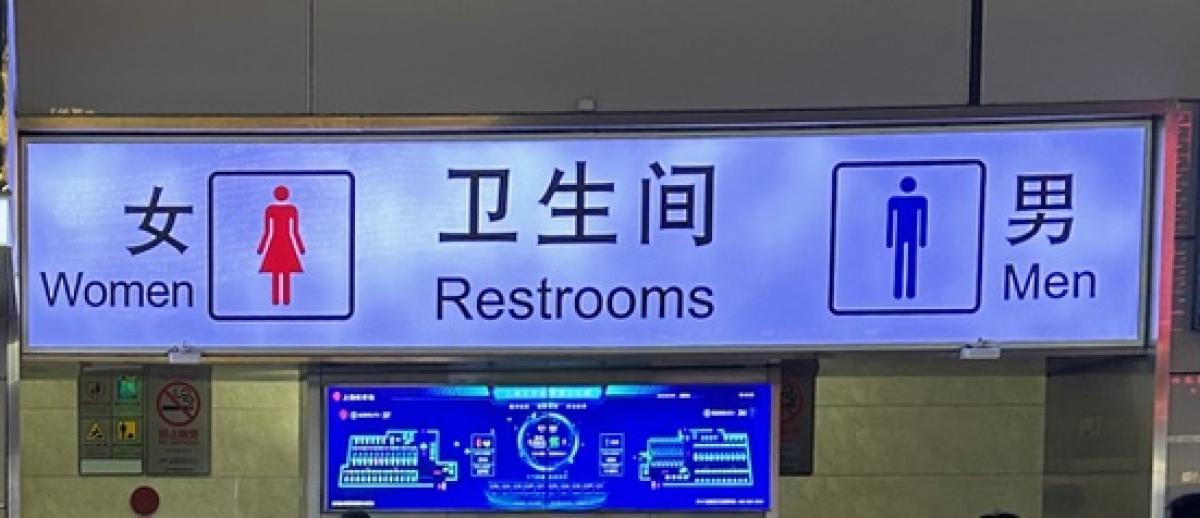Flush with Data: Mapping Fecal Biodata Capitalism
archive


Public toilet monitoring station in a train station in Shanghai | Photo Credit: Tina Guirguis
Flush with Data: Mapping Fecal Biodata Capitalism
Every time you flush your toilet, valuable information about your health, habits, medications, and vices, is sent into the ether, to be aggregated, analyzed, and commodified. In fact, all your biological tissues and wastes are fair game. Whether it’s a biopsy sample taken by your doctor, blood drawn at a lab, or other biological sample imbued with biovalue – once these tissues are “abandoned” into “safe hands,” they no longer remain your property (Waldby and Mitchell 2006). As technologies, such as the toilet, that facilitate even the most banal aspects of everyday life emerge and expand, more and more information on society is generated. Lefebvre offers a speculative approach to analyze the role of information in the everyday and in upholding capitalism and existing social arrangements. The everyday has been colonized by capitalism and turned into a zone of consumption and boredom that allows capitalism to reproduce itself (Lefebvre 1991). Building on this insight, I propose the term biodata capitalism to name a contemporary regime in which bodily tissues, DNA, and even feces are transformed into sources of data, speculation, and profit.
While surveillance capitalism (Zuboff 2019) turns what we do, particularly in the digital sphere, into proprietary behavioral data that informs algorithms and marketing strategies, biodata capitalism turns what we are, our living and excreting bodies, into investible datasets, bespoke preventative healthcare, and downstream products and services. Biodata capitalism refers to the growing economic and political systems that treat human biological information including, but not limited to genetic data, biometric identifiers, health metrics, and bodily outputs such as feces and urine, as resources to be captured, analyzed, and monetized. Under biodata capitalism, biological materials and metrics become forms of capital: they are commodified, circulated, and used for prediction, governance, and profit. I develop this claim through discussion of three linked examples, centered around feces, that connect the home toilet to the research lab to the sewer in pursuit of turning our bodily excrement into capital: (1) biobanks and their pharmaceutical partners; (2) diagnostic fecal testing and associated bespoke products; and (3) wastewater surveillance, including both household smart toilets and population monitoring protocols.
The Colonized Everyday Meets Speculative Bioeconomy
Since the 1970s, the biological sciences have been incorporated into market logics and regimes of capital. Translational research came to the fore, promising tangible health outcomes while reorganizing research around commercialization, intellectual property, and investible futures. Emerging DNA technologies and shifts in U.S. legislation and regulation helped reshape how science is developed, monetized, and shared alongside neoliberalism. The rise of the life sciences and the biotech industry is entwined with neoliberalism’s promise to overcome the limits of industrial growth through speculative reinvention (Cooper 2008). Waste and tissue occupy a privileged place in this speculative horizon, as surplus materials that blur the line between abject and valuable, which are now recast as sources of future growth due to the translational data they contain.
The distinctive surplus of bodily tissue and data generated in this zone creates biovalue - value derived from biological fragments (tissue, stem cells, fecal matter) that, once isolated and engineered in the lab, become knowable, exploitable, and commodifiable (Waldby 2002). Biovalue is pursued both to improve human flourishing and to produce exchange value through patents, investors, and intellectual property. The turn to tissue and waste as sites of value creation signals a political economy in which the living and the abject are rendered as speculative investments. The outcome is the rise of markets of risk: diagnostics and predictive analytics that proliferate not by treating present disease but by expanding categories of the potentially sick, risk itself becomes a commodity (Mitchell and Waldby 2010).
Case Studies
Biobanks and Pharmaceutical Companies
Biobanks assemble archives of tissue and often linked to health records under the banner of public benefit in pursuing etiological knowledge, precision medicine, and improved health outcomes. Yet they are constitutively entwined with diagnostics, pharmaceutical industries, intellectual-property regimes, access agreements, and venture timelines. Participants appear as altruistic “donors,” yet their contributions become proprietary inputs for risk scores, drug pipelines, diagnostic panels, and downstream products governed by patents and exclusive licenses (Mitchell and Waldby 2010). In some contexts, donor samples are linked to national health records, fixing participants in productive relations with research infrastructures throughout life and even into death.
This formation exemplifies biodata capitalism. First, datafied bodies become enduring productive assets thanks to longitudinal linkages to health records, genomic updates, and recontact protocols. Second, risk markets proliferate through genetic risk scores, early diagnostic testing, and stratified prevention regimes enlarging demand for lifestyle interventions, supplements, and prophylactic drugs. In 2008, U.S. DNA diagnostics already exceeded two billion dollars; the logic is expansive because every new biomarker found via testing yields new categories of potential patients and treatments (Mitchell and Waldby 2010). Here, knowledge and value co-produce one another through new calculations of value and risk, which propel new pursuits and articulations of knowledge. Biobanks thus anchor a global bioeconomy in which the human body and the data derived from it are analyzed and altered to create commodities with surplus value in both health and profit.
Diagnostic Fecal Testing and Microbiome Mapping
If genomics opened one frontier of biodata capitalism, the microbiome is the bathroom door flung wide open to venture capital, transforming fecal waste into a data-rich substrate. Commercial stool kits invite people to collect, stabilize, and mail their own samples; machine learning translates microbial fragments into scores and personalized recommendations. Through stool sampling, microbiome mapping, and algorithmic recommendation engines, a wave of startups markets new diagnostics of risk and customized interventions from diet plans to bespoke probiotics. The test results rarely diagnose a present disease; rather, they locate one within probabilistic futures. This aligns with the preventive-risk expansion Mitchell and Waldby describe: markets grow by multiplying the potentially sick and the yet-to-be-optimized (Mitchell and Waldby 2010).
Fecal diagnostics also convert abjection into asset. What publics and policymakers long construed as dangerous effluent becomes an instrument for modeling populations and selling personalization. Laboratory protocols isolate microbial fragments; machine learning translates them into scores of dysbiosis or resilience; platforms route those scores to subscription regimens. Value accrues not only from the sale of kits and supplements but from the derivative potential of the data itself—usable by insurers, advertisers, and pharmaceutical partners for pricing, targeting, and research and development.
Biovalue is extracted from bodily samples that are “abandoned” (a sample given as part of your medical testing) or donated (via a biobank), gathered through clinical labor, the ongoing processes by which people provide in vivo and in vitro access to their bodies and data. Crucially, fecal testing extends clinical labor into the home. As individuals collect, stabilize, and ship their own stool; they become both subjects and technicians of sample production. This offloading of labor lowers costs and, by routinizing self-sampling, densifies the data exhaust on which biodata capitalism depends (Mitchell and Waldby 2010).
Flush with Data: Wastewater Surveillance and Household Smart Toilets
The newest and most invasive element of sanitary surveillance within biodata capitalism, marketed as a diagnostic and preventive tool, is the self-analyzing toilet. Research institutions and private partners, including initiatives connected to the Gates Foundation’s “Reinvent the Toilet Challenge,” have developed toilets that analyze fecal waste and urine in the bowl before flushing, pushing health information to an app. Prototypes from companies and universities (e.g., Toto, Stanford, Duke/Corprata) promise to recognize a user by their “analprint,” categorize stool, quantify biomarkers, and flag early disease. Such devices sit at the intimate hinge of infrastructure and interface, converting routine excretion into continuous data capture (Kan 2021).
At the population scale, wastewater surveillance has matured from an epidemiological tool popularized during COVID-19, to a normalized instrument of public health and security. By sampling wastewater flows in sewers, authorities can infer infection trends, drug consumption, or environmental exposures without individual consent. The ability to test wastewater to further know populations turns fecal waste into a tool of state risk management. Feces, which was once treated as a threat becomes a vantage point for tracking epidemics, drug use, and other indicators across neighborhoods, campuses, and cities.
Together, household smart toilets and wastewater surveillance instantiate two poles of biodata capitalism. In the home, personalization: device-mediated risk scores, subscription recommendations, and potential integration with telehealth, or wellness programs. Population analytics through aggregation in the sewer: collected excreta signals into dashboards that can coordinate public health interventions and, potentially, other policing or administrative actions. The depth of insight into habits, health, and vices raises questions about secondary uses, data brokerage, and the fold-in of fecal analytics into existing security architectures. Even where public deployments are limited or unclear, the technical feasibility and commercial incentives point toward further integration.
From Biovalue to Biodata
What distinguishes biodata capitalism from earlier formulations is not only the commodification of tissue but the platformization of bodily data across everyday infrastructures. Toilets, test kits, and biobanks do not merely collect samples, they generate data streams that circulate through databases, patents, and paywalled analytics. Knowledge and value co-produce one another at each step: a new biomarker begets a new subscription tier; a new risk score begets a new preventive market; a new data partnership begets a new class of eligible customers.
Biodata capitalism names the consolidation of an economic and governmental formation in which bodies and their wastes are mobilized as sources of speculative value and instruments of rule. Biobanks and pharmaceutical partnerships, fecal diagnostics and customized probiotics, self-analyzing toilets and wastewater surveillance together transform excreta from abject matter into investible data.
Cooper, Melinda. 2008. Life as Surplus: Biotechnology and Capitalism in the Neoliberal Era. Seattle: University of Washington Press.
Kan, Michael. "Toto's Wellness Toilet Will Analyze Your Poop." PC MAG, January 11, 2021. https://www.pcmag.com/news/totos-wellness-toilet-will-analyze-your-poop.
Lefebvre, Henri. 1991. Critique of Everyday Life, Volume III: From Modernity to Modernism. London: Verso.
Mitchell, Robert, and Catherine Waldby. 2010. “National Biobanks: Clinical Labor, Risk Production, and the Creation of Biovalue.” In Tissue Economies: Blood, Organs, and Cell Lines in Late Capitalism, 107–46. Durham, NC: Duke University Press.
Ong, Aihwa. 2006. Neoliberalism as Exception: Mutations in Citizenship and Sovereignty. Durham, NC: Duke University Press.
Sunder Rajan, Kaushik, and Sabina Leonelli. 2013. “Introduction: Biomedical Trans-Actions, Postgenomics, and Knowledge/Value.” Public Culture 25 (3): 463–75.
Waldby, Catherine. 2002. “Stem Cells, Tissue Cultures and the Production of Biovalue.” Health 6 (3): 305–23.
Zuboff, Shoshana. 2019. The Age of Surveillance Capitalism. New York: PublicAffairs.



